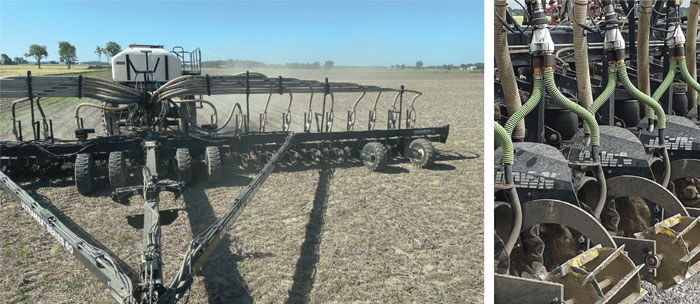Forty-five percent of strip-tillers make their strips in the fall, 33% in the spring and 21% do a little bit of both according to the 2024 Strip-Till Farmer Benchmark Study. Sparland, Ill., strip-tiller Jay Riddell and Kenton, Ohio, strip-tiller Brian Watkins weighed the benefits of fall and spring strip-till during a panel discussion with Strip-Till Farmer. They also touched on their nutrient management strategies, cover crop philosophies and more. Here are some highlights from the conversation.
Why did you start strip-tilling?
Riddell: We went from full tillage to strip-till with the goal of trying to get the nutrients where they need to be. We also have a large cattle operation, so strip-till made a lot of sense logistically and manpower-wise. We can go out there and plant and don’t have to get a field cultivator rolling ahead of us.
Watkins: We tried strip-till back in the 90s with some older equipment — essentially an applicator type knife. We struggled to get it done in the fall, mainly because by the time harvest was done, our soils were out of condition. We farm in heavy clay soils that we must tile. We switched to mostly no-till. But the thing that brought us back to strip-till was when we went to a spring operation, we weren’t running a shank. We were running a Dawn Pluribus unit, which is a good fit for us now. We’re still working up a good amount of soil, but we can do it in the spring.
Recently, we hired a custom strip-tiller to also make strips in the fall with a Kuhn Krause Gladiator shank machine. I didn’t think you could do that in our soils, but our neighbors showed me that it can be done in certain conditions. I think it’s important to be flexible. You can go into a spring ready to make strips, but the weather might dictate that it’s not such a great idea. If that’s the case, then we can still no-till, and if it’s reasonably dry, then strip-till is the way to go.
“You can go into a spring ready to make strips, but the weather might dictate that it’s not such a great idea…”
Riddell: I prefer making strips in the fall on my acres because it gives us peace of mind. I’ve often said that I’ll take a bad strip in the fall because I know it’s going to mellow out. It may not be that pretty in the fall, but come spring, it looks good, and I don’t have to worry about what the weather’s going to allow us to do.
Spring strip-till certainly has some validity in my area as well, where we also worry a little bit about erosion in the strips, especially if we’re frozen about 2 inches down and we catch a rain. That can be a problem. Because of that, we don’t run any rolling baskets on our strip-till bar in the fall and try to leave a pretty rough strip to battle that erosion.
Do you run a strip freshener in the spring?
Riddell: We don’t usually, but our neighbor bought a strip freshener this year and we ran it over a fair number of acres in the spring, really just trying to dry the ground out. We’re still trying to decide if it has a place in our system or not.
What nutrients are you applying with your strip-till rig?
Riddell: Our bar has two 6-ton Salford compartments. We run one prescription for potash and a separate prescription for a MAP, sulfur blend, so we’re blending it as we go across the field and applying at variable rates because we have management zones. In 2024, we used AMS. We make strips ahead of corn and soybeans on all our acres, and we’re putting dry fertilizer down for the most part.
The majority of our nitrogen program is usually sidedressed with anhydrous in the spring. I’m not a lover of dealing with anhydrous but I do like the product. It’s usually quite a bit cheaper in our area. It’s a product that, to me, is stable in the soil and it gives us a lot of late season N, which I think is what really boosts our yields. We decided after 2023 that we’d like to apply a little more nitrogen in our fall strips, but we didn’t want to put on anhydrous just then. So, going to AMS got us a little more nitrogen in the strip.
“I’ve often said that I’ll take a bad strip in the fall because I know it’s going to mellow ou…”
Watkins: In the spring, we’ve been primarily running a low base rate of NPK — 80 units of N, 20 units of P, 30 units of K and some zinc sulfate. We’ve had liquid rigs in the past but now we have a dry rig. With the dry rig, we used to run straight urea, which worked great for a long time until we had one disaster. One year, it was cold and dry, and it stayed cold and dry, and we got ammonia burn off the urea that burned the roots. We salvaged the crop, and it ended up yielding pretty well. But looking at it when it was about V3-V4, it looked terrible. We learned our lesson and we’ve switched to ESN.
Sulfur has become something that we’re totally focused on applying. We’re putting sulfur on everything now. We’ve done trials and we’ve seen other trials — sulfur on soybeans can easily give you 5-plus more bushels.
When a first-time strip-tiller is deciding whether to make strips in the fall or spring, what advice do you give them?
Watkins: I think there’s a place for both fall and spring. Every situation is different, but in our heavy clay soils, the ideal time to make strips is in the spring. You talk about freezing and thawing and how that can mellow things out. In heavy clay soils, sometimes we do tillage and the soil “re-compacts” harder than it was before. If you can make strips in the spring, I think you should do it. But if we do it in the fall, that’s going to be the first area that’s ready to plant in the spring. If we can get a day’s worth of planting while we’re starting to run the other strip-till rig, that’s where it makes sense.

SPRING STRIPS. Brian Watkins makes strips with a Harvest International toolbar and Dawn coulter units. He applies 60-80 units of N ahead of corn, split-applied outside of the coulter so it’s on either side of the berm. Brian Watkins
Riddell: I like the fall from a logistical standpoint. As soon as the harvest operation is wrapping up, we’re starting to make strips. Because of our soils and the freeze-thaw cycles, our strips are plenty adequate. We plant all our soybeans first before our corn, so we’re willing to go in there and plant in adverse conditions if need be. I can start planting soybeans before I could even think about dragging that strip-till bar through anything.
That being said, in 2024, we stripped several acres in February, which is the first time in my memory that I can remember ground conditions being like that. If you can tell me every year I’ll have ground conditions like that in February, then that’s when I’d do mine.
Do you use cover crops?
Watkins: We are heavy cover crop users. We do some double cropping with wheat. We plant cereal rye ahead of our soybeans. And we’ve been playing around with cover crops ahead of corn, doing a strip of cereal rye, like a 30-inch row of rye and then planting between it. After wheat harvest, we’ll use radish, kale, sunn hemp, rapeseed, clover, sunflowers. It’s a menagerie out there. The broader species of plants you have growing, the more different species of beneficials you’re going to have in the soil.
Fall vs. Spring Strip-Till
Click here to watch a panel discussion with technology editor Noah Newman, Brian Watkins & Jay Riddell about the pros & cons of fall & spring strip-till during the 2024 National Strip-Tillage Conference.
Riddell: We hire a guy to come in and drill rye right in our corn stalks that are going to beans. If he can’t be right behind the combine, then we stop him because I want that cover crop to germinate and establish itself. Then come next spring, looking from the road, you can’t tell those strips are there, but you go out there, plant it green, pull back the rye and you find those strips are right there. We’ve experimented with rye ahead of corn, but that cost us 20 bushels of corn one year, and we just couldn’t get over what we felt was the nitrogen penalty of it. We’ll do some more experimentation and try to find something cover crop-wise ahead of corn. I think there’s good value to building organic matter with the covers.







